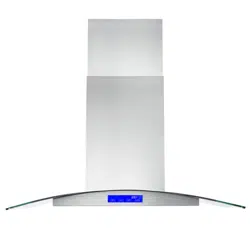Documents: Go to download!
User Manual
- User Manual - (English)
- Dimension Guide - (English)

- PARTS DIAGRAM
- INSTALLATION REQUIREMENTS
- LOCATION REQUIREMENTS
- VENTILATION REQUIREMENTS
- RANGE HOOD INSTALLATION
- RANGE HOOD USE
- REPLACING LED BULBS
- OIL CUP INSTALLATION
- SOFT TOUCH CONTROLS
- MAINTENANCE
- PERMANENT FILTERS INSTALLATION
- TROUBLESHOOTING
Table of contents
User manual Range Hood
PARTS DIAGRAM
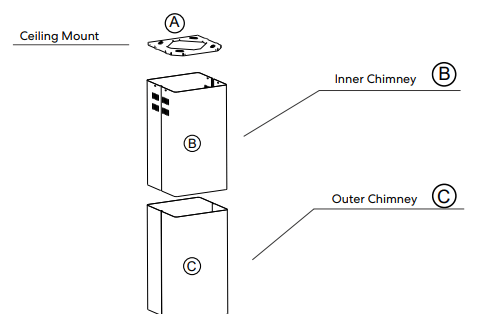
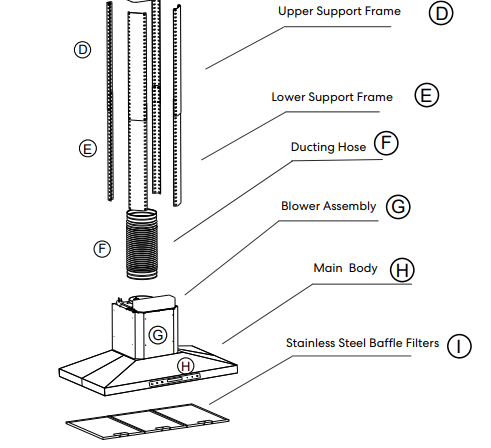
INSTALLATION REQUIREMENTS
TOOLS AND PARTS REQUIREMENTS
Electric Drill or Ratchet Driver
1/2" drill bit for drilling pilot holes
1 1/4" drill bit for drilling electrical wiring access hole
Screwdrivers; Phillips & Flat Head
Pliers
Tape measure or ruler and pencil
Electrical supplies for wiring
Aluminum foil tape and/or Duct Tape Hammer
Jigsaw or Saber Saw
Stud Finder
PARTS SUPPLIED
(A) Ceiling Mount
(B) Inner Chimney
(C) Outer Chimney
(D) Upper Support Frame
(E) Lower Support Frame
(F) Ducting Hose
(G) Blower Assembly
(H) Main Body
(I) Baffle Filters Hardware
* Hardware content may vary from model to model
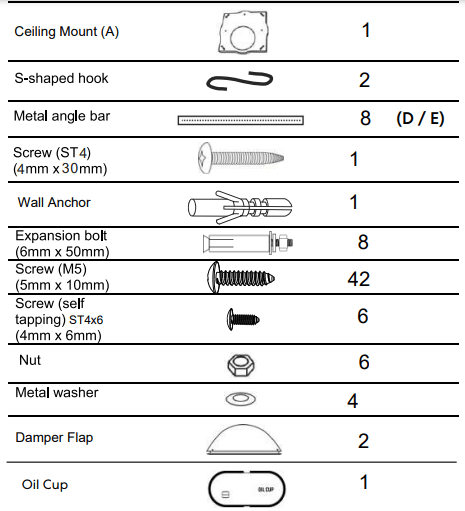
LOCATION REQUIREMENTS
IMPORTANT: Please observe all governing codes and ordinances. It is recommended that a qualified technician install the range hood. It is the installer's responsibility to comply with installation clearances specified on the model / product rating label. Range hood's location should be away from strong draft areas such as; windows, doors and strong heating vents. Cabinet opening dimensions that are shown must be used. Given dimensions provide minimum clearance.
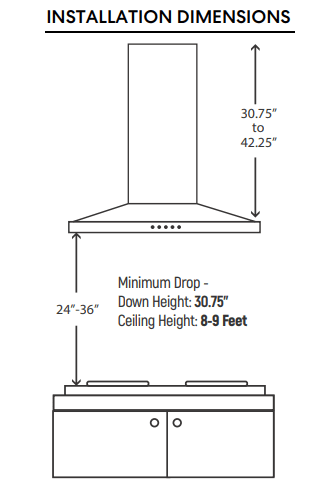
VENTILATION REQUIREMENTS
- Range hoods must be ventilated to the outdoors, except for non-vented (recirculating) installations. Part CFK1-TM is required (Sold Separately).
- Do not ventilate the range hood into an attic or other enclosed areas.
- Do not use 4" (10.2 cm) laundry-type wall caps.
- The length of the range hood and the number of elbows should be kept to a minimum to provide maximum performance.
For the most efficient and quiet operation
- Use no more than three 90° elbows.
- Make sure there is a minimum of 24" (61 cm) of straight duct between the elbows if more than one elbow is used.
- Do not install two elbows together.
- Use clamps to seal all joints in the vent system.
- The vent system must have a damper. If the roof or wall cap has a damper, do not use the damper supplied with the range hood.
- Use caulking to seal exterior walls or roof openings around the cap.
- The size of the vents should be uniform.
Cold Weather Installations
An additional back draft damper should be installed to minimize backward cold air flow. A thermal break should be installed to minimize conduction of outside temper atures as part of the vent system. The damper should be on the cold air side of the thermal break.
The break should be as close as possible to where the vent system enters the heated portion of the house.
Makeup Air
Local building codes may require the use of makeup air systems, when using ventilation systems greater than specified CFM of air movement. The specified CFM varies from state to state. Consult your HVAC professional for specific requirements in your area.
Venting Method
This range hood is factory set for through the roof or wall.
A 6" (15.2 cm) round vent system is needed for installation. The hood exhaust opening is 6" (15.2 cm) round.
To vent through a wall, a 90" elbow is needed.
If exhaust ducting with a diameter of less than 5.91" (150 mm) or if flat ducting is used, the noise level of the range hood will increase and extraction will be less efficient.
Rear Venting
A 90° elbow may be installed immediately above the hood.
For Ductless (Recirculating) Installations
If it is not possible to vent cooking fumes and vapors to the outside, the hood can be used in the non-vented (recirculating) version, fitting a carbon filter at the motor. Fumes and vapors are then recycled through the top grille. DO NOT block the chimney vent holes. See Page 16 for ductless conversion instructions.
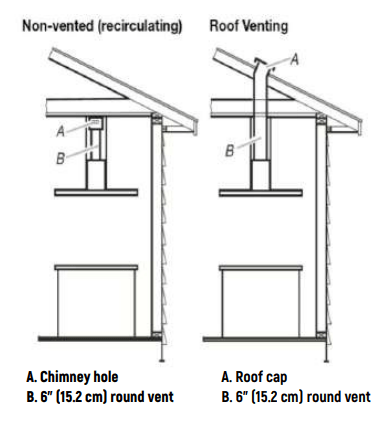
RANGE HOOD INSTALLATION
PREPARE LOCATION
- Lay out the vent duct system before installing the range hood to determine the best routing for the vent duct.
- It is recommended that the vent system be installed before the range hood is installed.
- Before making cutouts, make sure there is proper clearance within the ceiling for exhaust vent.
- Range hood is to be installed 24" (61.0 cm) min. for electric cooking surfaces, 27" (68.6 cm) min. for gas cooking surfaces, to a suggested maximum of 36" (91.4 cm) above the cooking surface.
- Remove film from metal surfaces as needed prior to assembly.
- Check your ceiling height and the range hood height maximum before you install your hood.
- Disconnect power.
- Determine which venting method to use: roof or non-vented.
Range Hood Mounting Screws Installation
- Determine and mark the centerline on the ceiling where the range hood will be installed, considering the requirements for ceiling support structures. See the "Location Requirements" section. Make sure the range hood is centered over the cooking surface.
- Use a pencil to mark the mounting screws, wire access and duct hole locations on the ceiling. NOTE: Mounting holes location should be into a ceiling support structure capable of holding 80 lbs (36.6 kg).
- Drill 4-3/16" (4.8 mm) pilot holes for mounting the upper horizontal support.
COMPLETE PREPARATION
- Determine the required location for the home power supply cable and drill a 1⁄2" (1.3 cm) diameter hole for wire access.
- Run 1⁄2" (1.3 cm) conduit and wires or home power supply cable according to the National Electrical Code or CSA Standards and local codes and ordinances. There must be enough 1⁄2" conduit and wires or home power supply cable from the fused disconnect (or circuit breaker) box to make the connection in the hood's electrical terminal box.
- For vented installations only: Using a jigsaw or keyhole saw, cut a 61⁄2" (16.5 cm) diameter hole for the vent duct.
- Install the ducting hose (F)

1. Position the (A) Ceiling Mount on the ceiling and mark the position of the screw holes. The mount should be securely attached to the ceiling.
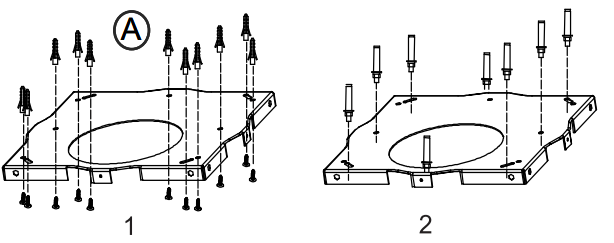
[1] 13 pcs ST4 x 30 Wood Screws + 13 Wall Anchors for Wood Mounting
[2] 8 pcs M6x50 Expansion Bolts for concrete Mounting
2. Attach the Angle Bars to the Ceiling Mount (A) using (8) M5 screws. Extend the Angle Bars to the required height and secure them using (16) M5 screws with nuts & metal washers.
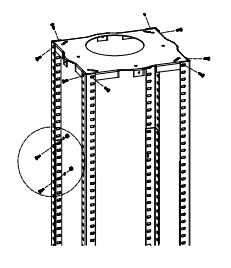
IMPORTANT: The angle bars must have an overlap of AT LEAST 100mm/4"
3. If your Island Range Hood is going to be used in ducted mode, connect the ducting hose (F) to the Ceiling Mount (A) at this point.
Fix the Upper Chimney (B) to the Ceiling Mount (A) using (4) ST4x6 self tapping screws.
Slide the Lower Chimney (C) onto the Support Frames (D/E) and raise it until it sits just below the Upper Chimney (B) section.
The "S" hook Holds the lower chimney up while the main body is lifted and fixed to the support frame in step 5.
* One end hooks onto the support frame, and the other end (bottom of the S) holds the the lower chimney up
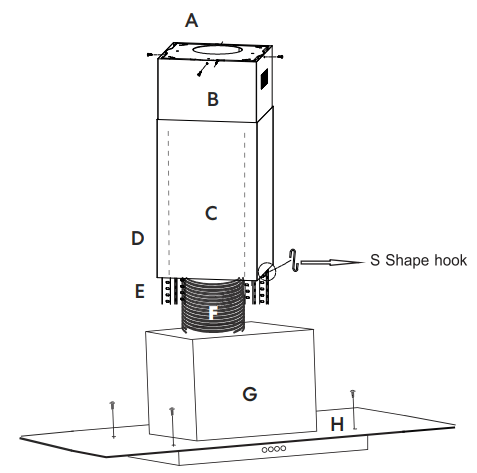
4. If the glass canopy has not been pre-assembled by the factory, then it should be attached to the top of the main body of the range hood at this stage.
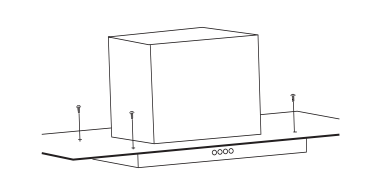
5. Lift the main body (G/H) of the range hood onto the support frames (D/E) and fix into position using [16] M5 screws.

IMPORTANT: This stage of the installation process MUST be completed by two people. The screws MUST be securely tightened.
6. If you are going to be using the hood in extraction mode (ducted), you should attach the ducting hose to the ceiling.
The electrical connection must correspond to the electrical requirements noted on the rating plate which is inside the range hood. The appliance should now be connected to the power supply.
Check that the appliance is operating correctly by selecting each speed and switching the lights on and off.
Remove the hanging hook and slide the lower chimney section down until it rests against the main body of the range hood.
Use a stainless steel cleaner to clean your hood after successful installation.
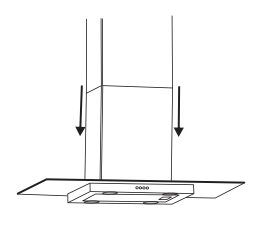
RANGE HOOD USE
The range hood is designed to remove smoke, vapors and odors. For best results, start the hood before cooking. After the process is complete, allow the range hood to run for several minutes to completely clear all the smoke and odors from the kitchen.

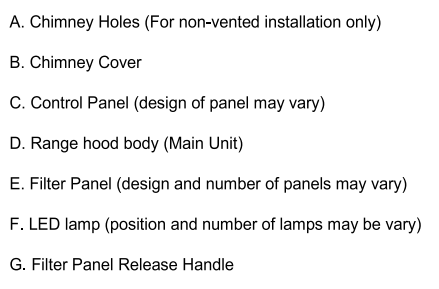
REPLACING LED BULBS
1. Switch the unit off and unplug the range hood.
2. Remove the lamp cover by unscrewing the 2 screws.
3. Unscrew the LED light.
4. Replace with the same type and rated light.
LED light (max, 1.5w)
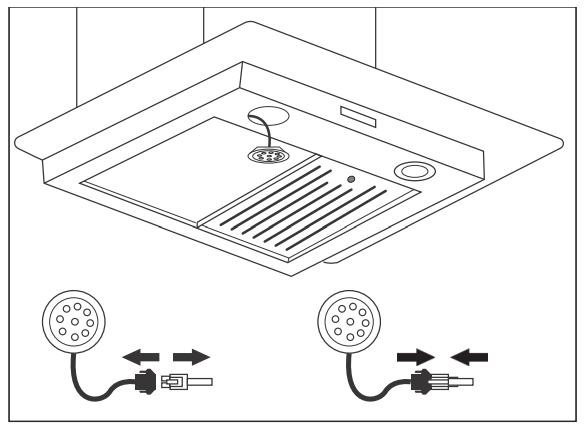
OIL CUP INSTALLATION
1. Line up Oil Cup
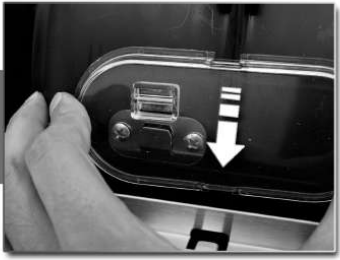
2. Pull down
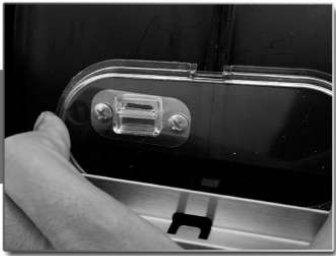
3. Snap into place
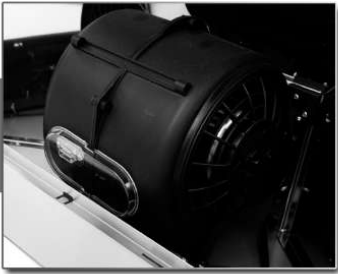
SOFT TOUCH CONTROLS
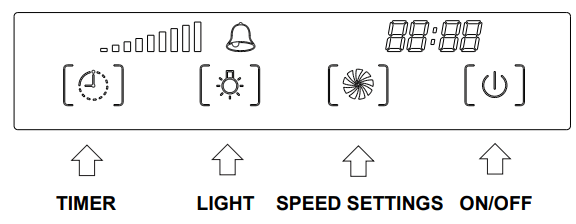
 Timer setting: Press once to add 1 minute delay auto shut-off. The maximum is 59 minutes.
Timer setting: Press once to add 1 minute delay auto shut-off. The maximum is 59 minutes.
 Press once for high speed, twice for middle speed, and three times for low speed, and recycle.
Press once for high speed, twice for middle speed, and three times for low speed, and recycle.
 Press to turn the Lights ON or OFF.
Press to turn the Lights ON or OFF.
 When the motor is working, press once to enter into 1 minute delay auto shut-off mode. Press again to turn off the motor immediately
When the motor is working, press once to enter into 1 minute delay auto shut-off mode. Press again to turn off the motor immediately
 To set the clock: Touch and hold the timer setting symbol for approximately 3 seconds.
To set the clock: Touch and hold the timer setting symbol for approximately 3 seconds.
 Touch (light button) to set hour.
Touch (light button) to set hour.
 Touch (Speed button) to set minutes.
Touch (Speed button) to set minutes.
MAINTENANCE
CLEANING
IMPORTANT: Clean the hood and grease filters frequently according to the following instructions. Replace panel filters before operating hood.
Exterior Surfaces
To avoid damage to the exterior surface, do not use steel wool or soap-filled scouring pads. Always wipe dry to avoid water marks.
Cleaning Method
Use liquid detergent soap and water, or all-purpose cleanser.
Wipe with damp soft cloth or non-abrasive sponge, then rinse with clean water and wipe dry.
Metal Baffle/Grease Filter
- Remove the filter by pulling the spring release handle and then pulling down the filter.

- Wash metal filters as needed in dishwasher or hot detergent solution.
- Reinstall the filter by making sure the spring release handles are toward the front. Insert aluminum filter into upper track.
- Push the spring release handle.
- Push up on metal filter and release handle to latch into place.
PERMANENT FILTERS INSTALLATION
- Line up filter Hooks to holes in unit.
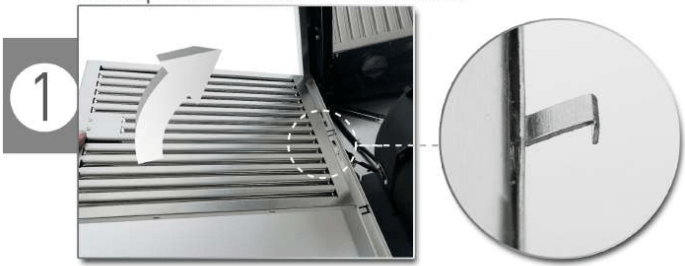
2. Lift filter for Hooks to go into holes.
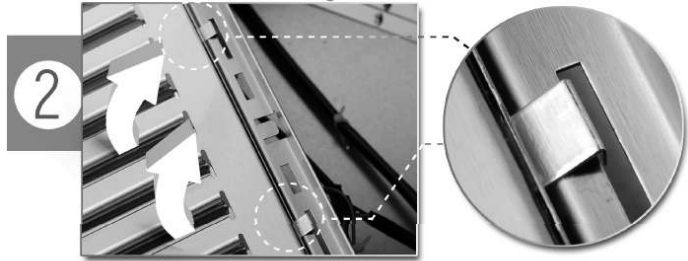
3. Lock Filter into place.

TROUBLESHOOTING
PROBLEM | SOLUTION | TOOLS |
| My range hood is noisy | A. Check inside the range hood for any loose debris and remove. If your range hood is still noisy after checking, please call 1-888-784-3108. | Phillips Screwdriver |
| My range hood has poor performance | A. The range hood and cooktop are too far away from each other. Optimal distance is 24" to 36" B. There are too many open windows or doors in the area. Close some doors or windows. C. The motor performance has decreased due to wear. Replace motor. D. Check and make sure the tape holding down the damper flaps at the vent hole are removed before use. E. The oil cup is full and needs to be cleaned out. F. The filters are clogged and need to be cleaned. | Phillips Screwdriver |
| My range hood shakes | A. The installation is not secure. Check again and make sure the installation hardware is securely mounted. B. The fan is broken or not balanced. Re-align or replace fan. C. The motor is loose. Check and make sure the motor is solidly mounted to the unit. D. Baffle filter is loose and is not installed correctly. Read page 12 for installation instructions | Phillips Screwdriver |
| Range Hood does not turn on | A. Make sure that range hood is plugged into powered outlet. Test outlet with other device if not working. B. Remove baffle filters, reach inside behind the control panel and locate the wire with clip. Make sure control panel is securely plugged in. C. Check the plastic clip connection coming out of the motor housing to make sure it's intact. | Phillips Screwdriver |
| Light bulbs went out | A. Replace with a new LED lamp assembly. B. Remove baffle filters, reach inside behind the control panel and locate the wire with clip behind the light housing. Make sure the light is securely plugged in. | Phillips Screwdriver |
IF YOU HAVE TRIED ALL SOLUTIONS AND STILL EXPERIENCE ISSUES, PLEASE CALL SUPPORT: 1-888-784-3108.
See other models: COS-668AS750 668A750 63175S COS-63175 COS-668ICS750
